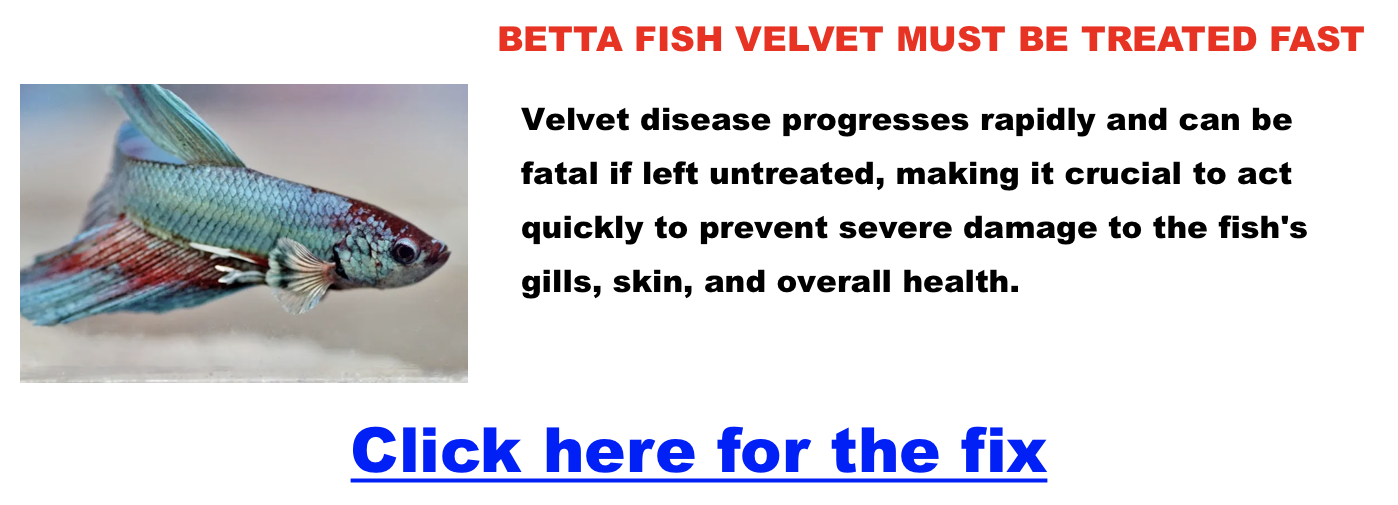Matt
Diagnosing & Treating Septicemia for a Betta Fish
Has your betta fish suddenly become lethargic, lost its appetite, or developed strange red streaks? These could be signs of septicemia, a serious bacterial infection that can quickly become life-threatening. This guide will walk you through everything you need to know about septicemia in betta fish, from identifying the symptoms to understanding treatment options.
Septicemia in Betta Fish: What is it?
Septicemia, also known as blood poisoning, occurs when a bacterial infection enters the bloodstream and spreads throughout the body. In betta fish, this can happen due to a variety of factors, such as:
- Wounds: Open sores or cuts on your betta’s body can provide an entry point for bacteria.
- Poor water quality: Dirty water with high levels of ammonia or nitrite can weaken your betta’s immune system and make them more susceptible to infection.
- Stress: Stressful conditions, such as overcrowding, aggressive tank mates, or sudden temperature changes, can also compromise your betta’s immune system.
Recognizing the Signs of Septicemia in Betta Fish
Early detection is crucial when it comes to septicemia. Look out for these common symptoms:
- Red streaks: Red streaks or patches on the body, fins, or tail are a hallmark sign of septicemia.
- Lethargy: Your betta may become less active, spending more time at the bottom of the tank.
- Loss of appetite: A decrease in appetite or complete refusal to eat is another warning sign.
- Rapid breathing: You may notice your betta breathing more rapidly or gasping for air at the surface.
- Fin clamping: Your betta may hold their fins close to their body.
- Ulcers or open sores: These can be a sign of advanced infection.
If you notice any of these symptoms, it’s important to act quickly.
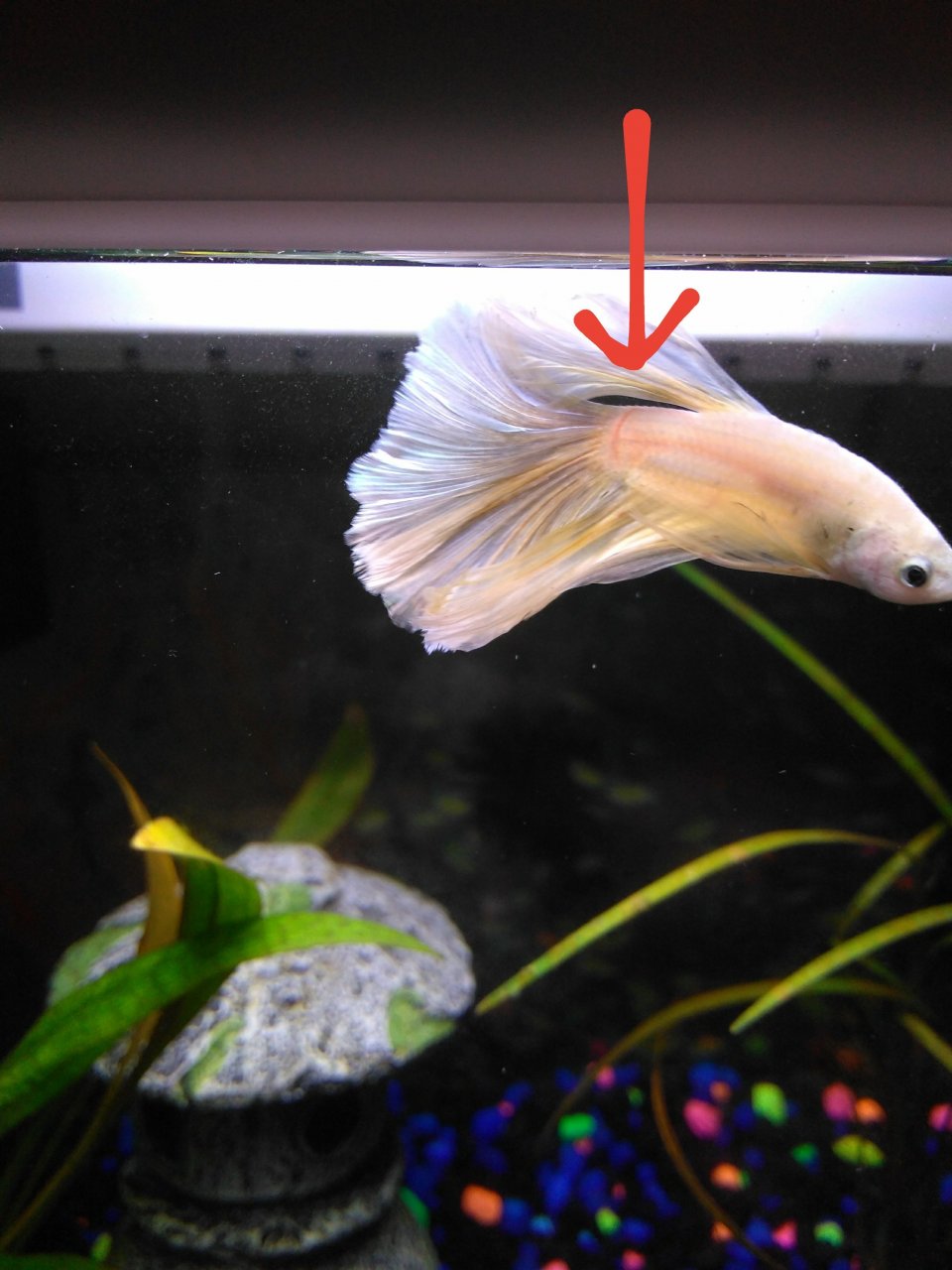
credit: My Aquarium Club
Diagnosing Septicemia in Betta Fish
If you suspect septicemia, it’s best to consult a veterinarian or experienced betta keeper for a definitive diagnosis. They may recommend additional tests, such as a water quality test or a microscopic examination of a skin swab, to confirm the presence of bacteria.
Treating Septicemia in Betta Fish
Treatment for septicemia typically involves antibiotics. Here’s a step-by-step guide on how to administer antibiotics to your betta fish:
- Consult a veterinarian or betta expert: Do not attempt to medicate your betta fish without consulting a qualified professional. They will prescribe the appropriate antibiotic medication and dosage based on your fish’s specific condition and weight.
- Prepare a hospital tank: Set up a separate tank for your betta to be treated in. This will help prevent the medication from affecting the biological filtration in your main tank. Use clean, aged water at the same temperature as your main tank.
- Dose the medication: Follow the veterinarian’s instructions carefully when measuring and adding the medication to the hospital tank. Common forms of betta fish antibiotics include liquid medications or medicated food.
- Monitor your betta closely: Observe your betta’s behavior and overall health throughout the treatment. Continue the medication for the full prescribed course, even if your betta seems to improve earlier. Stopping the medication too soon could allow the infection to return.
- Maintain water quality: Perform daily small water changes (around 25%) in the hospital tank to maintain good water quality. This is crucial for your betta’s recovery.
- Monitor water parameters: Keep an eye on your water temperature, ammonia, nitrite, and nitrate levels in the hospital tank.
Important notes:
- Antibiotics can be harsh on your betta’s digestive system. You may need to adjust their feeding schedule or feed them medicated food during treatment.
- Not all antibiotics are safe for aquarium snails or invertebrates. If you have other tank inhabitants, consult your veterinarian about alternative treatment options or house them in a separate tank during your betta’s treatment.
Preventing Septicemia in Betta Fish
Prevention is always better than cure! Here are some steps you can take to reduce the risk of septicemia in your betta fish:
- Maintain excellent water quality: Perform regular water changes, test water parameters, and use a reliable filter.
- Avoid overcrowding: Provide your betta with a spacious tank to minimize stress.
- Quarantine new fish: Before adding new fish to your betta’s tank, quarantine them for several weeks to ensure they are healthy and disease-free.
- Handle your betta gently: Avoid causing injuries that could provide an entry point for bacteria.
Betta Fish Tumor
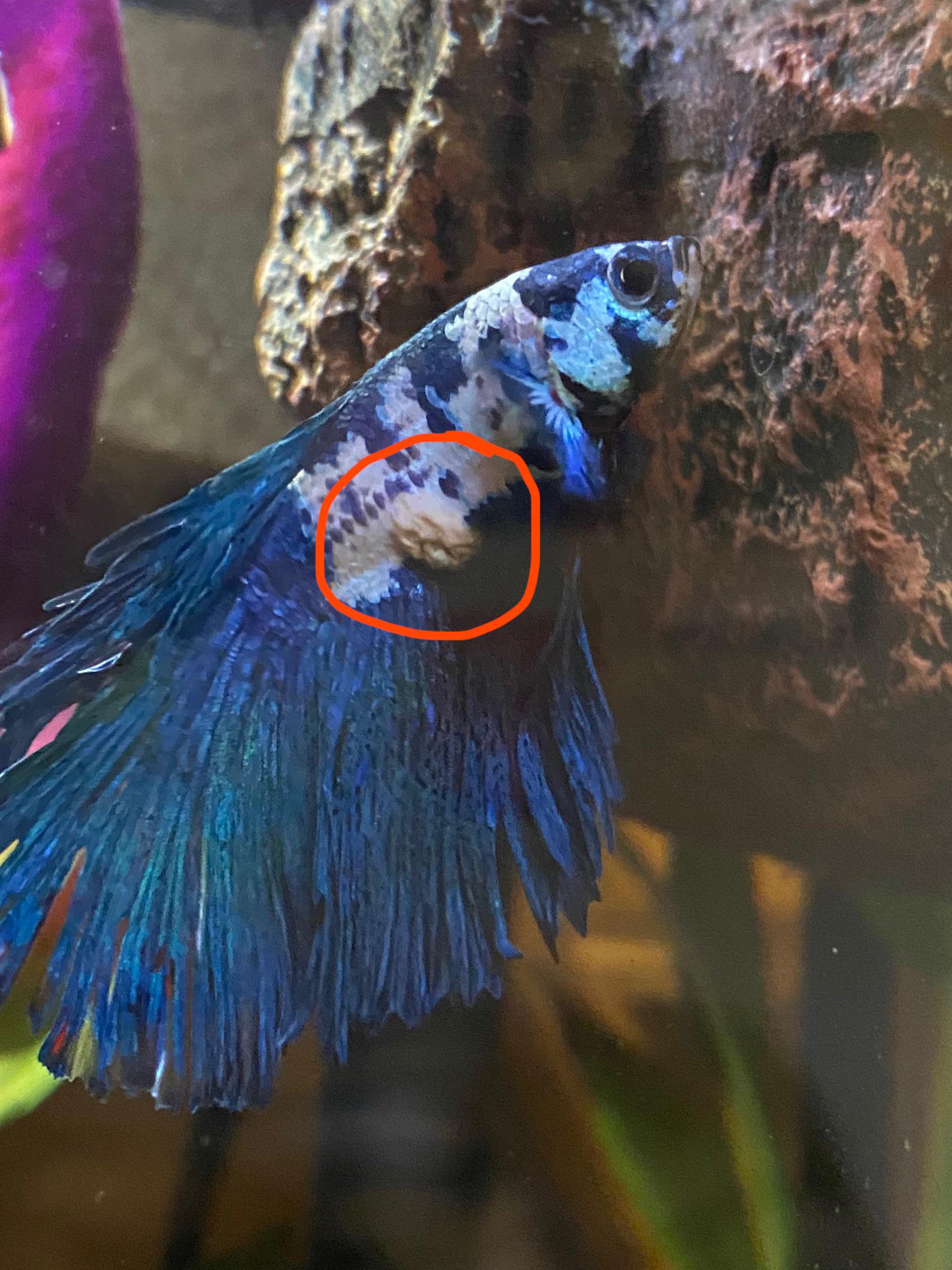
Betta fish tumor. Credit: reddit
Identifying a Tumor in Your Betta
Click here for the betta fish care guide ebook
Betta fish are loved for their stunning colors, graceful fins, and energetic nature, making them a favorite among aquarium enthusiasts. So, it’s natural to feel worried if you notice a lump or tumor-like growth on your betta.
The reassuring news is that not all tumors are harmful, and with the right care, many can be treated or managed. This guide will help you understand betta fish tumors, recognize the signs, and provide practical tips for treatment and prevention.
- Benign (non-cancerous): These are more common and typically don’t spread.
- Malignant (cancerous): Rare in bettas but potentially more harmful as they can invade tissues.
While tumors are often linked to genetics or aging, other factors, such as water quality and diet, can play a role.
Symptoms of Tumors in Betta Fish
Knowing the symptoms of tumors can help you act quickly:
- Visible Lumps: Tumors can vary in size, from small bumps to large growths.
- Discoloration: The lump may appear red, white, or darker than the surrounding tissue.
- Changes in Swimming Behavior: Difficulty swimming or balance issues.
- Lethargy: Decreased activity and prolonged resting at the bottom of the tank.
- Loss of Appetite: Refusing food or eating less than usual.
- Breathing Difficulty: Gasping at the surface or rapid gill movement.
If you observe any of these symptoms, consult a veterinarian specializing in fish care for a diagnosis.
Causes of Tumors in Betta Fish
Tumors can result from a variety of factors, including:
- Genetic Predisposition
- Some bettas are more prone to tumors due to their breeding lineage.
- Poor Water Quality
- High ammonia, nitrite, or nitrate levels stress your betta, weakening their immune system.
- Low-Quality Diet
- Nutritional deficiencies can increase the risk of tumor development.
- Infections
- Bacterial or fungal infections may cause abscesses or growths that resemble tumors.
- Aging
- Older bettas are more likely to develop tumors due to natural cell mutations.
Not All Lumps Are Tumors
Before assuming a lump is a tumor, consider these possibilities:
| Condition | Description | Treatment |
|---|---|---|
| Abscess | A localized infection that appears as a white lump. | Clean water, antibacterial medication. |
| Fungal Infection | Cotton-like growth on the body. | Antifungal treatments like methylene blue. |
| Ulcers | Red, inflamed sores caused by infections or injuries. | Water quality improvement, antibacterial medication. |
| Dropsy | Bloating due to kidney failure, often with pinecone-like scales. | Epsom salt baths, antibacterial treatment, and supportive care. |
| Swim Bladder Disease | Caused by constipation, injury, or infection; affects buoyancy. | Fasting, feeding deshelled peas, or using medications for underlying infections. |
| Parasites | Lumps caused by parasites like velvet or columnaris. | Antiparasitic medication. |
How to Treat Tumors in Betta Fish
Isolate the Fish
Move your betta to a quarantine tank to reduce stress and prevent potential spread of infection.
Check Water Parameters
Ensure the water is pristine. Ideal parameters for bettas are:
- pH: 6.5–7.5
- Ammonia: 0 ppm
- Nitrite: 0 ppm
- Nitrate: Less than 20 ppm
- Temperature: 78–80°F
Use Medication (If Necessary)
Depending on the type of tumor, you may need:
- Antibacterial treatments for abscesses or ulcers.
- Antifungal medications for fungal growths.
- Aquarium salt to support general healing.
Maintain a Stress-Free Environment
Provide plenty of hiding spots and avoid sudden changes to their tank setup.
Preventing Tumors in Betta Fish
Prevention is key to your betta’s health:
- Feed High-Quality Food: Choose nutritionally balanced betta pellets and supplement with live or frozen treats.
- Ensure Clean Water: Perform weekly water changes and use a reliable filter.
- Quarantine New Fish: Avoid introducing pathogens by isolating new fish before adding them to the tank.
- Avoid Stressors: Provide a stable, enriched environment with hiding spots and gentle water flow.
When to Consider Euthanasia
If your betta’s tumor becomes untreatable and they show signs of severe discomfort, euthanasia may be the kindest option. Use clove oil as a humane method to minimize suffering.
Betta Hole In Head: Causes, Treatment, Prevention
If you’ve noticed small holes or pits on your betta fish’s head, don’t panic. While alarming, hole-in-the-head (HITH) disease is a common ailment that can be successfully treated and even prevented with the proper knowledge and care. This guide will walk you through everything you need about HITH, from its causes and symptoms to treatment and prevention strategies.
What is Hole in the Head Disease?
HITH is not just a cosmetic issue; it’s a sign of an underlying health problem. The disease manifests as small holes or lesions, usually on the head but sometimes along the body. These holes can deepen and become infected if left untreated. It’s important to distinguish HITH from the natural sensory pits that some betta fish have along their lateral line. These pits are typical and not a cause for concern.

credit aquariumcoop.com
Causes of Hole in the Head Disease
Click here if you want to learn how to heal ‘hole in head’ phenomenon
HITH has several potential causes, often acting in combination:
- Poor Water Quality is the most common culprit. High levels of ammonia, nitrite, and nitrate, along with improper pH and temperature, stress the fish and weaken their immune systems.
- Parasites and Bacteria: Hexamita, Spironucleus, and other microorganisms can thrive in poor water conditions and infect the fish, leading to HITH.
- Nutritional Deficiencies: A lack of vitamins (especially vitamin C) and minerals can compromise the fish’s immune response, making them more susceptible to disease.
- Environmental Stress: Factors like overcrowding, aggressive tank mates, or inadequate hiding places can stress the fish, leading to health problems.
- Genetics: Some bettas may have a genetic predisposition to HITH.
Symptoms to Watch For
Early detection is crucial for successful treatment. Watch for these signs:
- Small holes or pits: Initially, they may look like tiny indentations on the head.
- Discoloration: The area around the holes may lose color or appear red and inflamed.
- Mucus or slime: Excess mucus production around the head.
- Behavioral changes: Loss of appetite, lethargy, hiding, or rubbing against objects in the tank.
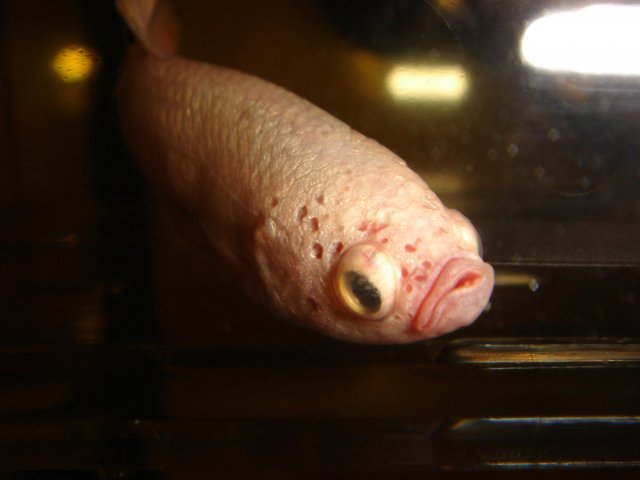
credit: Aquariacentral.com
Treating Hole in the Head Disease
If you suspect HITH, act quickly. The earlier you intervene, the better the chances of recovery. Treatment usually involves:
- Improving Water Quality: Perform frequent water changes, test water parameters regularly, and ensure the tank is adequately filtered and maintained.
- Medications: Anti-parasitic and antibacterial medications may be necessary. Consult a betta fish care guidebook for diagnosis and treatment recommendations.
- Dietary Adjustments: To boost the fish’s immune system, offer a high-quality diet rich in vitamins and minerals. Consider adding vitamin C supplements.
- Stress Reduction: Optimize the tank environment by providing adequate hiding places, removing aggressive tank mates, and avoiding overcrowding.
Preventing Hole in the Head Disease
Prevention is always better than cure. Here’s a comprehensive plan to keep your betta fish healthy and thriving:
- Maintain Pristine Water Quality: This is the cornerstone of betta health. Perform weekly partial water changes of 25-50%, depending on your tank size and bioload. Use a reliable water testing kit to monitor ammonia, nitrite, and nitrate levels and keep them within safe ranges for bettas (ammonia and nitrite at zero, nitrate below 20 ppm). Invest in a good-quality filter appropriate for your tank size and ensure it’s properly maintained.
- Provide a Nutritious Diet: Betta fish are carnivores and require a protein-rich diet. Choose high-quality betta pellets as the staple food, and supplement with frozen or live bloodworms, brine shrimp, or daphnia a few times a week. Avoid overfeeding, as this can contribute to water quality problems.
- Create a Stress-Free Environment: Stress is a significant weakening factor for fish. Provide your betta with an appropriately sized tank for its needs (at least 5 gallons for a single betta). Decorate the tank with live or silk plants to offer hiding spots and enrich the environment. Avoid tank mates that could nip at the betta’s fins or bully it. If you must have tank mates, choose peaceful community fish like celestial pearl danios or neon tetras.
- Quarantine New Fish: New arrivals can introduce diseases to your existing fish. Set up a quarantine tank and house new fish there for several weeks before introducing them to the main tank. This allows you to monitor them for any signs of illness and prevents potential outbreaks in your main display.
Columnaris Treatment, Symptoms, & Disease
Have you noticed your vibrant betta fish looking less active lately? Are there any unusual white or cotton-like growths on their body or fins? These could be signs of, a common and potentially serious bacterial infection in bettas.
But don’t panic – with early detection and proper care, your betta can recover and thrive again. This comprehensive guide will help you understand, treat, and prevent in your beloved aquatic companion.
What is Columnaris?
Columnaris, also known as cotton wool disease or saddleback disease, is caused by the bacteria Flavobacterium columnare. This bacterium is present in most aquariums, but it only becomes a problem when the fish’s immune system is weakened or when there’s an injury. The bacteria then attack the fish’s skin, fins, and gills, causing lesions, tissue damage, and potentially even organ failure.

Columnaris forming around the gills and down the side of the body
Symptoms of Columnaris in Bettas
Flexibacter columnaris, also known as columnaris or cotton wool disease typically shows the following symptoms:
- White or grayish cotton-like growths on the body, fins, or mouth
- Redness or inflammation of the skin and fins
- Fin rot (frayed or disintegrating fins)
- Lethargy and loss of appetite
- Difficulty breathing or gasping at the surface
- Skin ulcers or lesions
Recognizing these symptoms early is crucial, as columnaris can progress rapidly and become life-threatening. If you suspect your betta has columnaris, read on for the treatment recommendation.
Causes and Risk Factors of Columnaris & Betta Fish Cotton Wool
Several factors can contribute to columnaris outbreaks in betta fish:
- Poor water quality: High ammonia or nitrite levels, low pH, and fluctuating temperatures can stress bettas and make them more susceptible to infections.
- Stress: Overcrowding, aggressive tank mates, sudden environmental changes, and poor nutrition can weaken a betta’s immune system.
- Injury: Open wounds or abrasions provide an entry point for the bacteria.
- Betta’s anatomy: Their long, flowing fins and delicate skin make them more vulnerable to infections.
Treating Columnaris in Betta Fish
- Isolate the fish: Move the affected betta to a clean quarantine tank with appropriate water parameters and filtration.
- Start medication: Get API PIMAFIX which is designed to rapidly treat fungal infections using an all-natural extract from West Indian Bay Trees.
 Click here to learn more about Pimafix
Click here to learn more about Pimafix
- Perform water changes: Change 50% of the water daily during treatment and maintain optimal water parameters.
- Monitor the fish: Observe the betta closely for signs of improvement or worsening symptoms. In consultation with a veterinarian, adjust treatment as needed.
- Continue treatment: Complete the full course of medication even if the fish appears to have recovered.
- Prevent reinfection: Maintain excellent water quality, minimize stress, and quarantine new fish to prevent future outbreaks.
Columnaris Treatment Options
- Antibiotics: The most effective treatment for columnaris is antibiotics. Kanamycin, furan-2, and erythromycin are commonly used. Follow the dosage instructions exactly and complete the full course of treatment.
- Antibiotics:
- Kanamycin & Furan-2: 7-10 days
- Why not longer:
- Antibiotic Resistance: Overuse or prolonged use of antibiotics can lead to antibiotic-resistant bacteria, making future infections more difficult to treat.
- Organ Damage: Extended exposure to antibiotics can potentially damage the fish’s internal organs, such as the liver and kidneys.
- Disruption of Beneficial Bacteria: Antibiotics can also harm beneficial bacteria in the fish’s gut and in the aquarium, potentially leading to digestive issues and imbalances in the nitrogen cycle.
- Why not longer:
- Maracyn-Two: 5-7 days (Often used in conjunction with another antibiotic, so the total duration may be longer)
- Why not longer:
- Similar risks to other antibiotics: While Maracyn-Two is generally considered safe for fish, prolonged use can still lead to antibiotic resistance, organ damage, and disruption of beneficial bacteria.
- Why not longer:
- Kanamycin & Furan-2: 7-10 days
- Antibiotics:
- Antibacterial Baths: These can be used in conjunction with antibiotics or as a standalone treatment for mild cases. Prepare a bath with a suitable antibacterial medication and follow the instructions on the label.
- Water Changes: Frequent water changes (50% daily) are essential for removing bacteria and waste products from the tank, promoting healing, and preventing reinfection.
- Aquarium Salt: Adding aquarium salt can help reduce stress, improve gill function, and create a less hospitable environment for bacteria.
Preventing Columnaris
The best way to deal with columnaris is to prevent it from happening in the first place. Follow these tips to keep your betta healthy and free from infection:
- Maintain optimal water quality: Test your water regularly and keep ammonia, nitrite, and nitrate levels at zero. Maintain a stable temperature and pH within the ideal range for bettas.
- Quarantine new fish: Quarantine them in a separate tank for at least two weeks. This will allow you to observe for any signs of illness and prevent the spread of disease to your established fish.
- Minimize stress: Provide your betta with a spacious tank, plenty of hiding places, and a varied diet. Avoid overcrowding and aggressive tank mates. Make gradual changes to their environment and avoid sudden fluctuations in water temperature.
Betta Fish Names Generator
Try Our Betta Fish Name Generator
Betta Fish Name Ideas
Getting a betta? You might want to check out this care guidebook.
| Appearance | Personality | Inspired Names | Gender Specific |
|---|---|---|---|
| Red | Energetic | Ember, Flare, Ruby | Male: Apollo, Mars |
| Blue | Calm | Aqua, Sapphire, Neptune | Female: Luna, Venus |
| Purple | Royal | Amethyst, Violet, Regal | Male: King, Thor |
| Multi-colored | Playful | Kaleidoscope, Rainbow, Mosaic | Female: Aurora, Rainbow |
| Crowntail | Majestic | King, Queen, Crown Jewel | Male: Sir Fin, Duke |
| Veiltail | Graceful | Princess, Seraphina, Angel | Female: Duchess, Lady |
Dive into Personal Connections
Think of the things that make you you. What are your passions? Maybe your betta could be named “Sirius” after your favorite Harry Potter character or “Maui” if you love Moana. Perhaps a special word in another language holds meaning for you. A nickname from a funny memory or inside joke could also be the perfect fit.
Name by Appearance
Your betta’s stunning colors and unique features can be a goldmine for names. A fiery red betta might be “Ember” or “Crimson,” while a shimmering blue one could be “Sapphire” or “Neptune.” Does your fish have elegant, flowing fins? Maybe “Queen,” “Princess,” or “Prince” would be fitting. Even unique patterns or markings can inspire names like “Spot,” “Marble,” or “Ziggy.”
Capture Personality
Is your betta a little ball of energy zooming around the tank? Names like “Flash,” “Zippy,” or “Sparky” could capture that spirit. Or perhaps your fish is more laid-back and chill. “Zen,” “Peaceful,” or “Tranquil” might be more suitable. Maybe your betta is constantly exploring and curious. “Finnegan,” “Dory,” or “Curious George” could be fun options.
Gender-Specific Names (Optional)
If you know your betta’s gender, you can choose a name that fits accordingly. For males, classic names like “Apollo,” “Thor,” or “Hercules” might be appealing. For females, elegant names like “Athena,” “Luna,” or “Aurora” could be a great match.
Bonus Tips for Brainstorming Success
- Write it all down: Don’t be afraid to jot down any idea that pops into your head. You never know what might spark inspiration!
- Mix and match: Combine words from different categories to create unique names. “Blue Moon,” “Ember Star,” or “Zen Warrior” are just a few examples.
- Say it out loud: How does the name sound when you say it? Does it feel suitable for your fish?
- Research: Look up meanings and origins of names to add depth and symbolism.
Betta Eye Problems
Betta fish are captivating creatures that make wonderful pets, but like all living beings, they can experience health issues. One area that requires attention is their eyes. Understanding betta eye anatomy and recognizing potential problems is crucial for ensuring their well-being. In this guide, we’ll delve into the world of betta eye health, shedding light on common issues and offering guidance on prevention and treatment.
If your betta is suffering from eye trouble, consider checking out our betta fish care guide which talks about these issues and their treatment. Otherwise read this post because we dive into some common eye issues you might notice with a betta fish.
Common Betta Eye Problems
| Eye Problem | Description |
|---|---|
| Popeye (Exophthalmia) | One or both eyes bulge outwards, often caused by poor water quality, injury, or infection. |
| Cloudy Eye | Eye becomes cloudy or opaque, possibly due to bacterial infection, parasites, or injury. |
| Eye Flukes | Small parasites attaching to the eye, causing irritation and inflammation. |
| Cotton Wool Disease | Fungal infection affecting the eyes, causing swelling and a white, cottony growth. |
- Popeye (Exophthalmia): One of the most noticeable eye issues in bettas is Popeye, a condition where one or both eyes protrude or bulge outward. This bulging can be caused by bacterial infections, injuries, poor water quality, or even a gas bubble disease. Along with the bulging, you might observe cloudiness, redness, lethargy, and a decreased appetite in your betta.
- Cloudy Eye: A cloudy or hazy appearance over the eye is another common problem. This is often a result of bacterial or fungal infections, parasites, injuries, or subpar water conditions. Your betta might also experience redness or swelling around the eye.
- Other Eye Issues: Bettas can also develop cataracts, which appear as cloudiness within the lens of the eye, or corneal ulcers, which are open sores on the cornea. They can also develop a cotton-like appearance, and eye flukes.
PopEye
Eye problems can be very dangerous if you don’t take action. Click here.
Popeye, or exophthalmia, is a condition where one or both eyes of a betta fish swell and protrude abnormally from the head. This condition can be caused by infections, physical trauma, or poor water quality. If left untreated, can lead to blindness or even eye loss.
Popeye is a pretty obvious issue – see the picture below.

Normal Betta Eyes vs Popeye
Take a look at the table below which compares normal healthy betta eyes vs bettas suffering from popeye. We cover size, clarity of the eye, behavior changes, causes, treatment, and more.
| Feature | Normal Betta Eyes | Popeye (Exophthalmia) |
|---|---|---|
| Size & Shape | Proportional, round, and symmetrical | One or both eyes are swollen and bulging abnormally |
| Clarity | Clear, no cloudiness or discoloration | Cloudy, white, red, or hazy appearance |
| Symmetry | Both eyes are the same size and shape | One or both eyes may be larger or deformed |
| Fluid Retention | No excess fluid buildup | Eye may have fluid accumulation, appearing swollen |
| Behavior | Responds to movement and light normally | May show lethargy, reduced vision, or lack of response |
| Causes | Healthy conditions, no infections or injuries | Bacterial/fungal infection, injury, or poor water quality |
| Treatment Needed? | No treatment necessary | Requires clean water, salt baths, and possibly antibiotics |
| Risk of Eye Loss? | No risk | In severe cases, the eye may rupture or fall out |
| Prevention | Regular water changes, safe tank environment, balanced diet | Maintain clean water, avoid sharp objects, quarantine new fish |
Click Here to Heal Betta Fish Eyes
Normal Betta Fish:
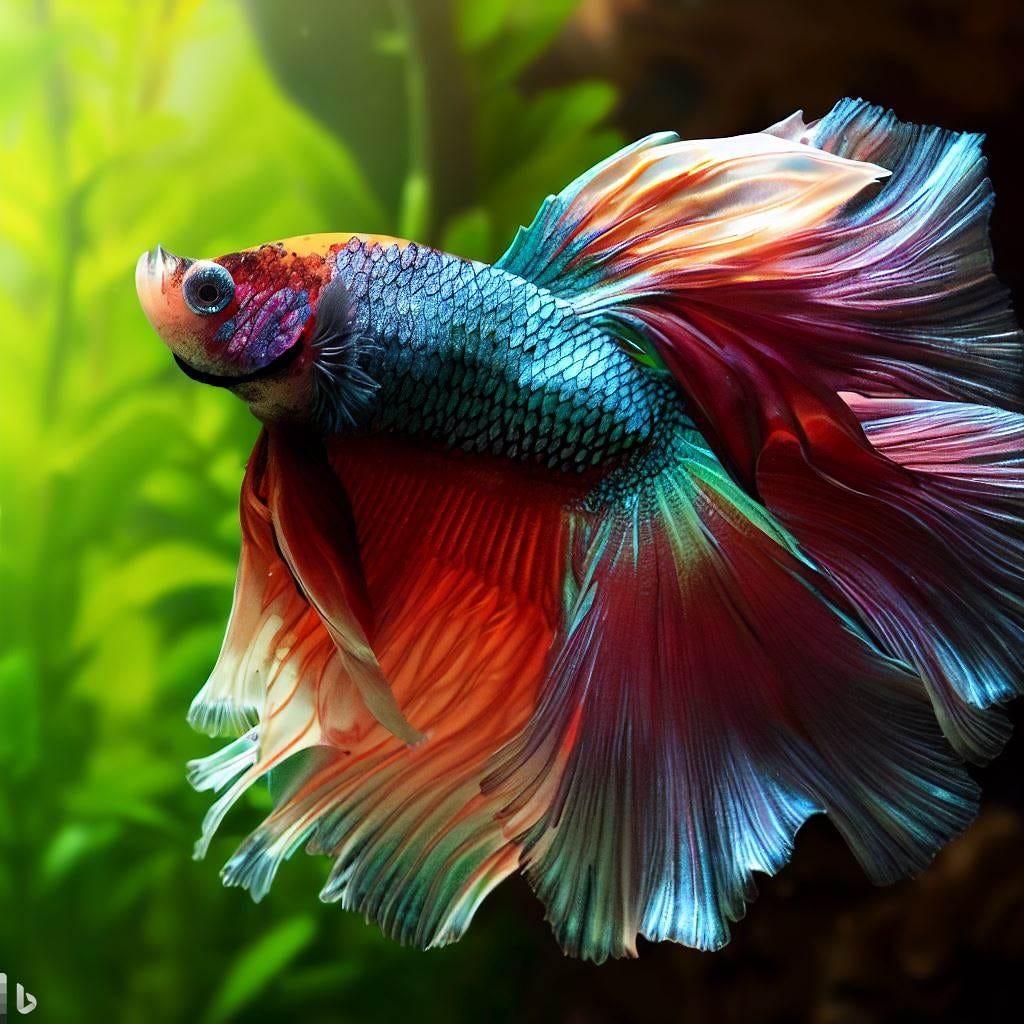
- Eyes are clear and symmetrical.
- No bulging or protruding eyes.
- Healthy appetite and active swimming behavior.
Betta Fish with Popeye:

- One or both eyes are swollen and protruding.
- Eyes may appear cloudy or discolored.
- Often accompanied by redness or inflammation around the eye.
- Fish may exhibit lethargy, loss of appetite, and difficulty swimming.
Treating and Preventing Betta Eye Problems
Seeking Professional Help: If you notice any abnormalities in your betta’s eyes, it’s crucial to consult a veterinarian who specializes in fish. They can diagnose the issue and recommend treatment.
Home Care and Remedies: Depending on the cause, you can try some home remedies while awaiting veterinary advice. For mild cases of Popeye, Epsom salt baths can sometimes help reduce swelling. If the problem is related to water quality, immediate partial water changes and addressing the root cause are essential. It’s also important to quarantine any affected fish to prevent the spread of infection.
Cloudy Eye
A hazy or opaque appearance in one or both of your betta’s eyes is indicative of a cloudy eye. This condition often stems from bacterial or fungal infections, parasites, injuries, or poor water quality. Accompanying symptoms may include redness or swelling around the eye, lethargy, and a decreased appetite.
Treatment and Prevention:
- Water Quality: If water quality is the culprit, immediate partial water changes and addressing the underlying issue (such as ammonia spikes or high nitrite levels) are crucial.
- Medication: For bacterial or fungal infections, consult a veterinarian for appropriate medication. Antifungal or antibacterial treatments might be necessary.
- Quarantine: Isolate the affected betta to prevent the spread of infection to other fish in the tank.
- Supportive Care: Maintain pristine water conditions, ensure adequate filtration and aeration, and feed a nutritious diet to bolster your betta’s immune system.
Eye Flukes
Eye flukes are tiny parasites that latch onto a betta’s eyes, causing irritation, inflammation, and discomfort. You might observe your betta rubbing their eyes against objects or flashing (darting around erratically) in an attempt to dislodge the parasites.
Treatment and Prevention:
- Medication: A veterinarian can prescribe anti-parasitic medication to eliminate eye flukes.
- Quarantine: Isolate the affected betta to prevent the spread of parasites to other fish.
- Water Changes: Perform frequent partial water changes to help reduce the number of parasites in the tank.
- Cleanliness: Maintain a clean tank environment to minimize the risk of parasite infestations.
Cotton Wool Disease
Cotton wool disease, a fungal infection, can manifest as white, cottony growths on your betta’s eyes, causing them to appear swollen and irritated. This condition often arises due to stress, poor water quality, or a weakened immune system.
Treatment and Prevention:
- Medication: Antifungal medication prescribed by a veterinarian is typically necessary to treat cotton wool disease.
- Water Quality: Improve water quality by performing frequent water changes and ensuring proper filtration.
- Stress Reduction: Minimize stress by providing a suitable environment with ample hiding places and avoiding overcrowding.
- Quarantine: Isolate the affected betta to prevent the spread of the fungal infection.
Betta Fish Behavior Before Death

Watching your Betta fish struggle in its final days can be an emotionally taxing experience. Recognizing the signs of decline early can give you a chance to intervene, provide comfort, or prepare for what’s to come. Here’s how to identify the most common signs that your Betta is nearing the end and what you can do to make their last days as peaceful as possible.
****Spotting the Warning Signs of Betta Fish Decline – Don’t Wait Until It’s Too Late
To help you quickly identify critical signs, here’s a comparison chart showing common Betta fish behaviors in healthy vs. dying fish:
| Behavior | Healthy Betta | Dying Betta |
|---|---|---|
| Activity Level | Active, exploring | Lethargic, barely moving |
| Appetite | Eager, responsive to feeding | Refuses food, spits out food |
| Fins | Spread out, vibrant | Clamped, torn, discolored |
| Swimming Pattern | Smooth, controlled | Erratic, floating sideways |
| Breathing | Calm, rhythmic | Rapid, gasping at surface |
| Color | Bright, vibrant | Dull, faded, pale |
| Skin/Scales | Smooth, clear | White patches, lesions |
| Balance | Steady | Floating, sinking, struggling |
Click here for Our eBook and Save Your Betta!
Bettas are known for their vivid colors and lively personalities, but when they’re nearing the end of their life, their behavior changes dramatically. Look for these critical signs:
Lethargy and Decreased Activity – The First Signs of Trouble
When a once-active Betta spends more time lying at the bottom of the tank or floating listlessly, it’s often a sign of declining health. This can be caused by poor water conditions, stress, or underlying illness.
What to Do:
- Test water parameters for ammonia, nitrites, and pH.
- Maintain water temperature between 78-80°F.
- Add aquarium salt to reduce stress and discomfort.
Loss of Appetite – A Disturbing Indicator
If your Betta suddenly refuses food or spits it out, it could indicate stress, infection, or digestive problems. Bettas typically have a strong appetite, so ignoring food is a significant warning sign.
What to Do:
- Isolate the Betta in a separate hospital tank.
- Offer soft, easy-to-digest foods like brine shrimp or daphnia.
- Administer anti-parasitic or anti-bacterial treatments if necessary.
Clamped Fins – A Clear Sign of Stress or Sickness
Healthy Betta fins fan out gracefully. When they stay clamped close to the body, it usually signals distress or infection. Stress from poor water conditions, parasites, or bacterial infections can cause this.
What to Do:
- Improve water quality through frequent water changes.
- Apply a stress coat to the water to soothe irritated skin.
- Treat with antibacterial medication if fins appear frayed or deteriorating.
Erratic Swimming and Floating Issues – Is Your Betta Losing Control?
A Betta struggling to swim properly may have swim bladder disease. This condition can cause them to float sideways, sink, or wobble uncontrollably.
What to Do:
- Fast the Betta for 24 hours to alleviate constipation.
- Lower the water level to make swimming less strenuous.
- Add Indian almond leaves to calm the fish and reduce inflammation.
Labored Breathing – Gasping for Air
Gasping at the surface or rapid gill movement often indicates that the Betta is struggling to get enough oxygen. This could be due to ammonia poisoning, poor water quality, or a bacterial infection.
What to Do:
- Perform a 50% water change to reduce toxins.
- Increase oxygenation with a gentle air stone.
- Treat for gill parasites or bacterial infections as needed.
Color Fading – When Vibrance Turns to Dullness
A once-vibrant Betta that appears dull or pale is likely under stress or suffering from illness. This symptom is common in aging fish but can also signal severe stress.
What to Do:
- Maintain stable water conditions to minimize stress.
- Offer nutrient-rich foods to strengthen their immune system.
- Remove aggressive tank mates to prevent bullying.
White Patches, Fungal Growths, or Parasites – The Signs of a Severe Infection
If your Betta has white cotton-like patches, small spots, or unusual skin lesions, it may be suffering from a fungal infection, Ich, or other parasites.
What to Do:
- Increase the water temperature to 82°F to inhibit parasites.
- Apply antifungal or antiparasitic treatments as needed.
- Isolate the Betta to prevent the spread of infection.
Fin Rot – The Silent Killer
Fin rot causes the edges of the fins to fray and blacken. It is typically caused by bacteria in unclean water and can rapidly deteriorate a Betta’s health.
What to Do:
- Isolate the Betta in a hospital tank.
- Administer antibacterial medication.
- Perform regular water changes to prevent further infection.
Loss of Balance – The Last Cry for Help
If your Betta is floating sideways, upside down, or struggling to stay upright, it may have swim bladder disorder or neurological issues.
What to Do:
- Fast for 24 hours to relieve constipation.
- Administer Epsom salt baths to reduce swelling.
- Lower the water level to minimize exertion.
How to Comfort a Dying Betta Fish – Creating a Peaceful End
If your Betta shows multiple signs of decline and treatment isn’t working, it’s time to focus on comfort care. Here’s how to make their final days as calm and pain-free as possible. Here’s how to provide a calm and peaceful environment:
- Reduce water flow to prevent stress.
- Offer soft, easy-to-digest foods like frozen brine shrimp.
- Keep the tank dimly lit to minimize stress.
- Maintain a consistent water temperature to avoid shocks.
Is Euthanasia the Kindest Option? When to Let Go
If your Betta’s condition continues to worsen despite treatment, humane euthanasia may be the kindest choice to prevent further suffering. The most accepted method is using clove oil, which induces a painless sleep.
Preventing Betta Fish Decline – How to Keep Your Betta Thriving
Consistent care can prevent many health issues in Bettas. Here are some essential practices:
- Test water parameters weekly to catch early signs of water quality issues.
- Maintain a stable temperature and use a heater to prevent temperature shock.
- Quarantine new fish buddies before introducing them to the main tank.
- Avoid overfeeding and maintain a varied diet to promote digestion and prevent constipation.
How To Treat Betta Fish Suffering From Velvet
Betta fish, with their dazzling beauty, are remarkably resilient creatures. However, like any living being, they can fall ill. One potential illness to be aware of is velvet, a parasite that can pose a significant threat to your betta. But fear not! With the right plan, you can effectively treat velvet and help your betta regain their vibrant health.
What is Velvet?
Velvet isn’t a fabric mishap on your betta. It’s a nasty parasite clinging to your fish’s skin and fins. Here’s how to spot it:
- Golden Dust: Look closely. Does your betta’s color seem off? Velvet can make them look like they’re covered in fine, gold or rust-colored dust.
- Scratching: Parasites are itchy! Your betta might rub against things in the tank like they’re trying to scratch an itch they can’t reach.
- Strange Swimming: Velvet can make your betta uncomfortable, causing them to swim erratically or clamp their fins close to their body.
- Loss of Appetite: When a fish doesn’t feel well, they often don’t want to eat.
Treating Velvet
Click here if you want to learn how to cure velvet
Velvet is a serious condition, so it’s crucial to start treatment immediately upon spotting the signs. By doing so, you’re taking a proactive and responsible approach to your betta’s health. Here’s what you need to do:
- Isolate: Velvet is highly contagious. If you have other fish in the tank, immediately move your betta to a separate “hospital tank” for treatment.
- Dim the Lights: These parasites don’t like bright light. Dimming your betta’s tank or covering it with a towel can help disrupt their life cycle.
- Raise the Temperature (Carefully): Raising your tank water temperature to around 82°F speeds up the life cycle of the parasites, making treatment more effective. Caution: Do this slowly over a day or two; sudden temperature changes stress bettas.
Treat with Medications: Several medications can combat velvet. Here are some commonly used options:
- Malachite Green: This is a traditional anti-parasite treatment. Follow the dosage directions carefully.
- Copper Sulfate is another effective option, but be very precise with the dosage as it can be toxic to fish.
- Aquarium Salt: Not a cure-all, but it can assist medication in fighting the parasites.

credit: Betta fish forum
Important Notes:
- Always follow medication instructions to the letter. Overdosing can harm your fish.
- Remove carbon filters during treatment. Carbon filtration can take the medication out of the water.
- Don’t stop treatment too early! Even if your fish looks better, continue the medication as directed to ensure the parasites are completely gone.
Prevention for Velvet-Free Betta Bliss
While treating velvet is possible, it’s stressful for you and your fish. A healthy, parasite-free tank is everyone’s goal! Here are the most effective ways to keep velvet out of your betta’s beautiful home:
- Quarantine is Queen: This is the golden rule. A separate quarantine tank is absolutely essential. Keep new fish, plants, or decorations in this tank for at least two weeks. Before introducing these items to the main tank, observe the bettas closely for any signs of illness.
- The Salt Assist: Aquarium salt isn’t a magic velvet solution but a gentle defense booster. Add a small amount (follow product directions) to your betta’s tank during routine water changes. Salt helps your fish produce a healthy slime coat, making it harder for parasites to attach, and boosts their overall health.
- Stress-Free Zone: Stress weakens a fish’s immune system. Ensure your betta’s tank is the right size, has proper filtration, and offers plenty of hiding places. Avoid overcrowding, aggressive tankmates, and sudden changes to water temperature or light exposure.
- Food for Thought: A high-quality, balanced diet keeps your betta strong. Avoid overfeeding, which can degrade water quality and invite trouble.
- Pre-Loved Items? Proceed with Caution: Used tanks, equipment, or decorations might harbor unseen parasites. If possible, purchase new items. If you must use pre-loved supplies, thoroughly disinfect them with a bleach solution (carefully rinsed away afterward) or quarantine them separately for several weeks.
- Responsible Sourcing: Purchase fish from reputable stores or breeders with a good track record. Healthy fish are less likely to carry parasites. Visually inspect fish before bringing them home, and always quarantine new arrivals.
A Note on Plants: Live plants bring benefits but can also be a source of hidden parasites. Consider these options:
- Quarantine: Keep new plants in a separate tank for a few weeks.
- Tissue Culture Plants: These plants, grown in a sterile laboratory environment, are less likely to carry parasites.
- Plant Dips: Specialized dips are available to help disinfect plants before placing them in a tank. Research proper usage and be cautious; some solutions can harm certain plant types.
It’s Worth the Effort
While preventing velvet may require a little extra effort, it’s the kindest way to ensure your betta thrives. By following these guidelines, you’re creating an environment where your betta can shimmer and shine worry-free. This assurance should instill a sense of confidence and security in your betta’s health.
Ich On Betta: What It Is & How To Treat It

Betta fish are cherished for their vivid colors and unique personalities, but like all fish, they are susceptible to diseases. One of the most common and serious conditions bettas face is Ich, or white spot disease. Ich is caused by the parasite Ichthyophthirius multifiliis, and it can be fatal if not promptly addressed. Understanding Ich’s life cycle, symptoms, and treatment options is going to be key to keeping your betta healthy.
What Is Ich and How Does Ich Spread on a Betta?
Ich, also known as ick or white spot disease, manifests as small, salt-like white spots on the body, fins, and gills of the fish. This parasite has a three-stage life cycle:
- Trophont Stage: The parasite attaches to the fish and feeds, appearing as white specks.
- Tomont Stage: The parasite detaches from the fish, settling in the substrate to reproduce rapidly.
- Theront Stage: The newly hatched parasites swim freely in search of a host, making this phase the most responsive to treatment.
Early Signs of Ich
If your betta develops ich, you’ll have a few visual cues to watch:
Visual Symptoms:
- Small, grain-like white spots on the body and fins.
- White patches may form on the head or gills.
- Potential color loss or ragged fins.
Behavioral Changes:
- Rubbing against tank decorations (flashing) as a response to irritation.
- Lethargy, increased hiding, and reduced activity.
- Labored breathing and clamped fins.
- Refusal to eat, signaling distress.
Outbreaks are often triggered by stressors such as poor water quality, sudden temperature changes, and the introduction of infected fish or plants without quarantine.
Treating Ich Effectively
If a betta has ich, it’s best to immediately move it to a hospital tank to prevent it from spreading to other fish in the tank. Then you’ll want to do the following to the water:
Initial Steps:
- Move the fish to a hospital tank to prevent the spread.
- Gradually increase the temperature to 81-86°F (27-30°C) using a reliable thermometer. This accelerates the parasite’s life cycle.
Medication Options:
Click here for my favorite ich treatment
- Use Ich-specific treatments containing malachite green or methylene blue. Products like Kordon Rid Ich Plus or API Super Ick Cure are popular choices.
- Always remove carbon filters during treatment, as they can absorb the medication.
Alternative Methods:
- Aquarium salt can be used to disrupt the osmotic balance of the parasite. However, it should be used cautiously as not all fish tolerate salt well.
- Maintain frequent water changes, around 25-50% daily, to remove free-swimming parasites and keep the water clean.
Treatment Duration:
- Continue the treatment for at least 7-10 days (or follow the medication instructions if using one). Even after the visible signs of Ich disappear, you’ll want to wait a little bit before transferring them back into their old tank. This ensures all parasites are eliminated, and that you won’t reintroduce it to the main tank.
Preventing Future Outbreaks of Ich
Ich can develop from a multitude of reasons such as stress, water quality, and when adding new fish to the tank. Here are some tips you can keep in mind which should help reduce the chances of ich developing on your bettas.
Quarantine New Arrivals:
- Always isolate new fish or plants for a minimum of two weeks to monitor for potential diseases before introducing them to your tank.
Maintain Excellent Water Quality:
- Regular water changes and monitoring of water parameters can help keep stress levels low and immune systems strong.
Reduce Stress Factors:
- Ensure the tank is spacious enough and free of aggressive tank mates.
- Stabilize water temperature and avoid sudden fluctuations.
Consider Preventative Measures:
- Adding a small amount of aquarium salt at a low dose can serve as a deterrent to parasites without harming your fish.
Helpful Tips for Effective Treatment
- Use a hospital tank for medication if you have sensitive invertebrates or multiple fish in the main tank.
- Provide a balanced diet to strengthen your betta’s immune system.
- Be patient and consistent with the treatment plan, as Ich can be persistent.
Final Thoughts
Prompt recognition and treatment of Ich are essential for the health of your betta fish. Early action, combined with comprehensive prevention strategies, can protect your fish from future outbreaks. Prioritize water quality, reduce stress, and monitor any new tank additions to maintain a thriving aquarium.
Betta Losing Color: Causes, What To Do To Fix
Betta fish, often referred to as the “jewels of the aquarium,” are celebrated for their vibrant colors. Observing a betta’s color fade can be concerning, as it may indicate underlying health or environmental issues. This article explores the potential causes of color loss in bettas and provides actionable steps to restore their vivid hues.
Understanding Betta Coloration
A betta’s striking colors result from specialized cells called chromatophores, which produce pigments influenced by genetics, health, and environmental factors. Sudden or gradual color loss often signals underlying issues that require attention.
Common Causes of Color Loss
Stress
Stress is a primary factor in color fading. Triggers include:
- Environmental Changes: Sudden alterations in tank setup, temperature fluctuations, or relocation can stress bettas.
- Incompatible Tank Mates: Aggressive or overly active companions can intimidate bettas, leading to stress.
- Overcrowding: Limited space can cause territorial disputes, increasing stress levels.
Illness or Disease
Several health issues manifest through color loss:
- Bacterial Infections: Conditions like Columnaris present as white or gray patches and can progress rapidly if untreated.
- Parasitic Infections: Diseases such as Ich (white spot disease) appear as small white lesions, resembling salt grains.
- Fungal Infections: These manifest as cotton-like patches on the skin, leading to color loss.
Poor Water Quality
Elevated levels of ammonia, nitrite, or nitrate can stress bettas, resulting in color fading. Infrequent water changes and inadequate filtration often contribute to deteriorating water conditions.
Aging
As bettas age, a natural dulling of color occurs, especially around the 2 to 3-year mark. This gradual change is typical and not necessarily indicative of health issues.
Dietary Deficiencies
A lack of nutrients can lead to diminished coloration. Bettas require a protein-rich diet to maintain their vibrant hues.
Diagnostic Steps
Behavioral Observation
Monitor for signs like lethargy, reduced appetite, or unusual swimming patterns, which can indicate stress or illness.
Physical Examination
Look for visible symptoms such as fin damage, spots, or lesions that might suggest infections or parasites.
Water Testing
Regularly assess water parameters using reliable test kits to ensure optimal conditions.
Preventive Measures and Solutions
Stress Reduction
- Stable Environment: Maintain consistent tank conditions, including temperature and lighting.
- Proper Tank Mates: Choose compatible species that coexist peacefully with bettas.
- Adequate Space: Provide at least a 5-gallon tank for a single betta to reduce territorial stress.
Disease Prevention and Treatment
- Quarantine New Additions: Isolate new fish or plants before introducing to the main tank to prevent potential infections.
- Prompt Treatment: We recommend using this care guidebook (page 38 covers this in detail.)
Water Quality Management
- Regular Maintenance: Perform consistent partial water changes, typically 25-30% weekly, to maintain cleanliness.
- Efficient Filtration: Ensure the filtration system is suitable for the tank size and bioload.
Nutritional Support
- Balanced Diet: Offer high-quality betta pellets supplemented with live or frozen foods like brine shrimp and bloodworms.
- Avoid Overfeeding: Feed small portions to prevent obesity and water contamination.
Conclusion
Maintaining the vibrant colors of your betta involves attentive care, a stable environment, and a nutritious diet. Regular observation and prompt intervention can ensure your betta remains healthy and dazzling.




